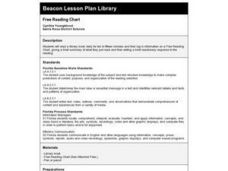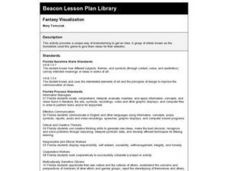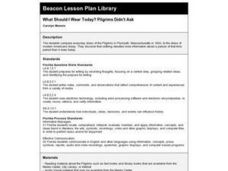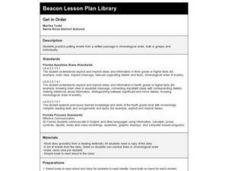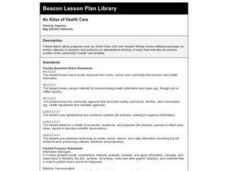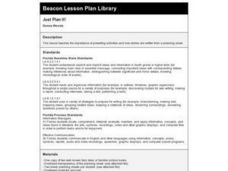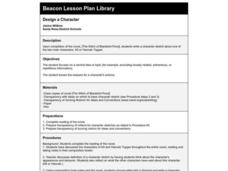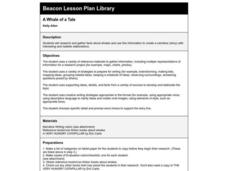Curated OER
Reading Stories in Art
Students study how artists tell stories using visual images by identifying and comparing elements of narrative (setting, characters, and plot) in a painting and a Greek vase.
School Improvement in Maryland
Supreme Court Case Overview I
As part of a study of the 14th Amendment to the United States Constitution, class members examine four Supreme Court decisions—Gitlow v. New York, Mapp v. Ohio, Gideon v. Wainwright, and Griswold v. Connecticut—that incorporated the due...
John Lentine
Butterflies and Bugs
Symmetry, line, shape, art, and math are all connected through a fun hands-on craft. Included are instructions to a classic activity, where learners create butterflies to show symmetry in nature and then discuss symmetry in math. It is...
Curated OER
Preventing Childhood Diseases Project
Second graders become informed advocates in the prevention of childhood diseases. This takes place during the Preventing Childhood Diseases Project.
Curated OER
Shoeless Math
First graders sort and classify, and complete a T-chart using Students' shoes.
Curated OER
The Seminoles
Students explore the Southeast Woodland region and culture of the Seminole Indians using video, art projects, books, maps and discussion.
Curated OER
Free Reading Chart
Students read library books daily for ten to fifteen minutes, log information on Free Reading Chart, giving a brief summary of what they just read, and write brief reactionary response to the reading.
Curated OER
Memorial Quilt
Young scholars explore the significance of memorials in the creation of their own memorial for the victims of 9/11. Through brainstorming and class discussion, they identify the characteristics of a memorial. Students use construction...
Curated OER
Fantasy Visualization
Students view and discuss a selection of paintings from Salvador Dali, Rene Magritte, and other Surrealist artists. They play a game in which each person in a group writes a sentence and passes it on to the next person without letting...
Curated OER
What Should I Wear Today? Pilgrims Didn't Ask
Second graders compare the clothing of today with the everyday dress of the Pilgrims.
Curated OER
What's the Story?
Students write a group continuation story after reading the novel, The Giver. They write a continuation of the story of Jonas' and Gabe's adventures in Elsewhere, then share their story with the class.
Curated OER
Tree Brains
Seventh graders use a tree as a graphic organizer for a prewriting strategy. Some of the "trees" are used to create verbal paragraphs for practice.
Curated OER
Get in Order
Young scholars practice putting events from a written passage in chronological order, both in groups and individually.
Curated OER
Health Education: Opinions
Third graders consider the opinions of others. In this personal health lesson plan, 3rd graders demonstrate how to effectively and respectfully express opinions that differ from others as they create and follow rules for productive...
Curated OER
A Taste of Blackberries
Fourth graders participate in a shared reading of Doris Buchanan's, A Taste of Blackberries. They read about grief in the loss of a best friend and examine the skills of a responsible family member.
Curated OER
An Atlas of Health Care
Students use educational software to create an alphabetical directory of maps that indicates the precise location of the community's health care facilities.
Curated OER
A Look Through Time
Second graders explore how people find out about history. They use previously gathered research to produce tourist pamphlets that highlight historical county events.
Curated OER
Regional Renaissances
Students investigate the differences between the Renaissance and the Northern Renaissance through group interaction and discussion. They write an essay after research.
Curated OER
Create Your Island Paradise
Sixth graders create a descriptive essay and map describing their island paradise. They try to evoke the reader's senses: seeing, hearing, touching, smelling, and tasting. They revise their paragraphs using their partner's feedback.
Curated OER
Tree Identification
Pupils list four ways to identify trees. In this tree identification instructional activity, students use tree identification techniques such as leafs, bark, wood grain, soil type, and climate to create tables and graphs.
Curated OER
Writing a Formal Thank You Letter
Students research various formats for writing thank you letters in resource books and through a provided Internet site. They use these resources to write a thank you letter to a recent outside speaker who visited their class.
Curated OER
Just Plan It!
Fourth graders practice using a planning sheet for a well-known fairy tale or picture book.
Curated OER
Disasters - Where, When, Why
Fourth graders research natural disasters that have occurred in the US in the 20th Century. They create a computer database of the disasters and write a paragraph with the information.
Curated OER
A Whale of a Tale
Learners read "A Very Hungry Caterpillar" and discuss factual information in the book. They research whales and use information to write a narrative story. They take their stories through the writing process.








